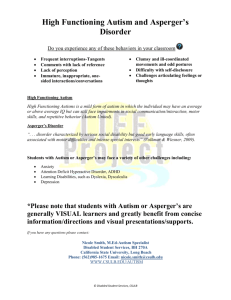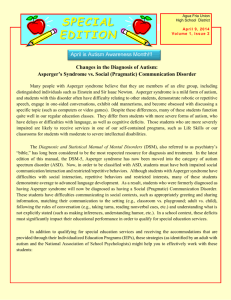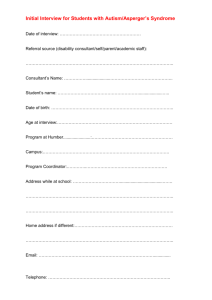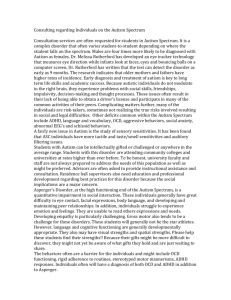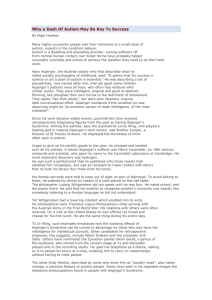*Interviewee: James Sheffield
advertisement
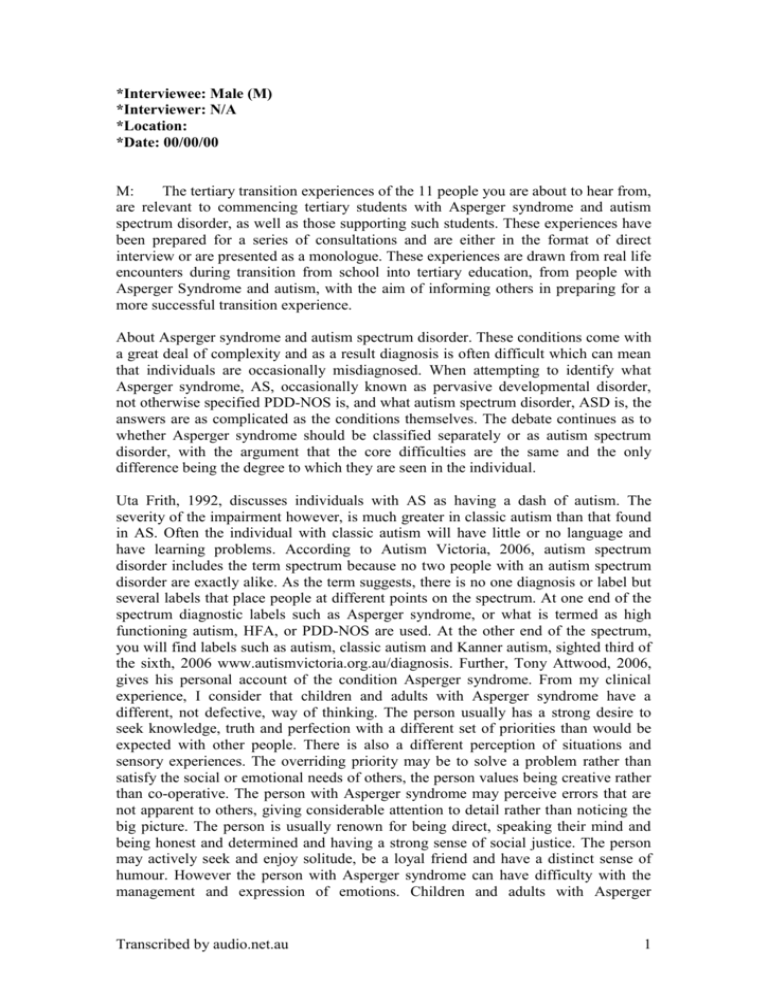
*Interviewee: Male (M) *Interviewer: N/A *Location: *Date: 00/00/00 M: The tertiary transition experiences of the 11 people you are about to hear from, are relevant to commencing tertiary students with Asperger syndrome and autism spectrum disorder, as well as those supporting such students. These experiences have been prepared for a series of consultations and are either in the format of direct interview or are presented as a monologue. These experiences are drawn from real life encounters during transition from school into tertiary education, from people with Asperger Syndrome and autism, with the aim of informing others in preparing for a more successful transition experience. About Asperger syndrome and autism spectrum disorder. These conditions come with a great deal of complexity and as a result diagnosis is often difficult which can mean that individuals are occasionally misdiagnosed. When attempting to identify what Asperger syndrome, AS, occasionally known as pervasive developmental disorder, not otherwise specified PDD-NOS is, and what autism spectrum disorder, ASD is, the answers are as complicated as the conditions themselves. The debate continues as to whether Asperger syndrome should be classified separately or as autism spectrum disorder, with the argument that the core difficulties are the same and the only difference being the degree to which they are seen in the individual. Uta Frith, 1992, discusses individuals with AS as having a dash of autism. The severity of the impairment however, is much greater in classic autism than that found in AS. Often the individual with classic autism will have little or no language and have learning problems. According to Autism Victoria, 2006, autism spectrum disorder includes the term spectrum because no two people with an autism spectrum disorder are exactly alike. As the term suggests, there is no one diagnosis or label but several labels that place people at different points on the spectrum. At one end of the spectrum diagnostic labels such as Asperger syndrome, or what is termed as high functioning autism, HFA, or PDD-NOS are used. At the other end of the spectrum, you will find labels such as autism, classic autism and Kanner autism, sighted third of the sixth, 2006 www.autismvictoria.org.au/diagnosis. Further, Tony Attwood, 2006, gives his personal account of the condition Asperger syndrome. From my clinical experience, I consider that children and adults with Asperger syndrome have a different, not defective, way of thinking. The person usually has a strong desire to seek knowledge, truth and perfection with a different set of priorities than would be expected with other people. There is also a different perception of situations and sensory experiences. The overriding priority may be to solve a problem rather than satisfy the social or emotional needs of others, the person values being creative rather than co-operative. The person with Asperger syndrome may perceive errors that are not apparent to others, giving considerable attention to detail rather than noticing the big picture. The person is usually renown for being direct, speaking their mind and being honest and determined and having a strong sense of social justice. The person may actively seek and enjoy solitude, be a loyal friend and have a distinct sense of humour. However the person with Asperger syndrome can have difficulty with the management and expression of emotions. Children and adults with Asperger Transcribed by audio.net.au 1 syndrome may have levels of anxiety, sadness or anger that indicate a secondary mood disorder. There may also be problems expressing the degree of love and affection expected by others. Fortunately we now have successful psychological treatment programs to help manage an express emotions, sighted the fifth of the sixth, 2006 www.tonyattwood.com.au. Significantly, with more and more research being completed on this complex topic by various experts in the field, the debate is concluding with AS being classified as a developmental disorder which falls within the autism spectrum disorder continuum. The transition from school into TAFE and higher education, can be a daunting and anxious time for any student, but is even more so for those with Asperger syndrome or autism spectrum disorder. On this CD you will hear from 11 individuals, these include Jillian, a young man with an incredible understanding of the meaning of determination. Rory describes his journey with AS and blindness as needing time for people to get to know him and likewise him time to know them. Donna's experience is an interview that traces the sometimes horrific and frequently enlightening journey of a known author who honestly tells of her battle with being inappropriately diagnosed, then later identified as having autism. Her strength shines through as she pushes forward to reach great academic achievements and is now a role model to many young people with similar conditions. Clemens and Louise explained the importance of early diagnosis and parental acceptance that may have made their life different. Others talk about the value of learning coping skills, for example the way to deal with anxiety and the real need to find a quiet space to collect thoughts and allow anxiety to pass. Interviews were undertaken by Deborah Cameron from the Professional Development Centre. For a complete transcript of this and other information on Asperger syndrome, along with transcripts of the 11 transition experiences from individuals with Asperger's or autism spectrum disorder, please go to www.rmit.edu.au/ssg/dco. The principle aim of this CD, is to help new students with their transition from school into TAFE, making the process much more manageable for others. We hope this CD provides support, encouragement and improves transition experiences for people with Asperger syndrome. Thank you. End of recording Transcribed by audio.net.au 2

